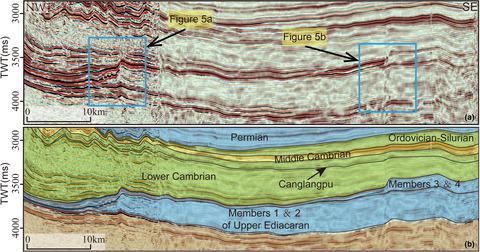当前位置:
X-MOL 学术
›
Basin Res.
›
论文详情
Our official English website, www.x-mol.net, welcomes your feedback! (Note: you will need to create a separate account there.)
The formation of the Sichuan Basin, South China, during the Late Ediacaran to Early Cambrian
Basin Research ( IF 3.2 ) Pub Date : 2021-02-15 , DOI: 10.1111/bre.12559 Zhidong Gu 1, 2 , Lidia Lonergan 2 , Xiufen Zhai 1 , Baomin Zhang 1 , Weihua Lu 1
Basin Research ( IF 3.2 ) Pub Date : 2021-02-15 , DOI: 10.1111/bre.12559 Zhidong Gu 1, 2 , Lidia Lonergan 2 , Xiufen Zhai 1 , Baomin Zhang 1 , Weihua Lu 1
Affiliation

|
The Upper Ediacaran to Lower Cambrian of the Sichuan Basin in South China has long been considered to be dominated by shallow-water deposition. Hydrocarbon exploration, however, has revealed that a NW-SE trending intraplatform trough formed in the basin during the same period. Although different models have been proposed, the formation and evolution of the trough are still not fully understood. In this study, we investigate both the origin of the intraplatform trough and the formation of the Sichuan Basin by integrating seismic interpretation, well correlation and tectonic subsidence analysis. The seismic and well data clearly show three stages of development of the trough. The first stage, in the early Late Ediacaran, is characterized by considerable thinning of the lower two members of the Upper Ediacaran from the platform margins to the trough. In the second stage, in the late Late Ediacaran, the platform margins backstepped and the extent of the trough expanded significantly to a width of ca. ~400 km. The third stage, in the early Early Cambrian, was dominated by gradual filling of the trough and onlapping of the platform margins. Backstripped tectonic subsidence curves show one, or two closely spaced episodes of linear subsidence starting at ~550 Ma and then decreasing exponentially until ~450 Ma. The shape of the subsidence curves is consistent with formation of the Sichuan Basin by low, and slow amounts of lithospheric stretching of thickened cratonic lithosphere. The tectonic subsidence increases from the centre to the NW of the basin. Interestingly the margins of the trough do not correlate with contoured values of increased tectonic subsidence and we infer that the trough was a palaeogeographic embayment in a large carbonate platform that developed in a broad, ramp-like area of slow and low subsidence tilting down to the proto-Tethyan ocean located to the NW of the basin.
中文翻译:

华南四川盆地形成于晚埃迪卡拉纪至早寒武世
长期以来,华南四川盆地上埃迪卡拉纪至下寒武统一直被认为以浅水沉积为主。然而,油气勘探表明,同一时期盆地内形成了一个 NW-SE 走向的台内槽。尽管提出了不同的模型,但对海槽的形成和演化仍未完全了解。在这项研究中,我们通过整合地震解释、井对比和构造沉降分析来研究台内槽的起源和四川盆地的形成。地震和井数据清楚地显示了槽的三个发展阶段。第一阶段,在晚埃迪卡拉纪早期,其特征是上埃迪卡拉纪的下部两段从台地边缘到海槽明显变薄。在第二阶段,在晚埃迪卡拉纪晚期,台地边缘后退,槽的范围显着扩大至约 100 米的宽度。约 400 公里。第三阶段,早寒武世早期,以海槽逐渐充填和台地边缘上覆为主。反剥构造沉降曲线显示了一个或两个紧密间隔的线性沉降事件,从~550 Ma 开始,然后呈指数下降,直到~450 Ma。沉降曲线的形状与四川盆地由加厚的克拉通岩石圈的低、缓慢的岩石圈伸展形成一致。构造沉降从盆地中心向西北方向增加。
更新日期:2021-02-15
中文翻译:

华南四川盆地形成于晚埃迪卡拉纪至早寒武世
长期以来,华南四川盆地上埃迪卡拉纪至下寒武统一直被认为以浅水沉积为主。然而,油气勘探表明,同一时期盆地内形成了一个 NW-SE 走向的台内槽。尽管提出了不同的模型,但对海槽的形成和演化仍未完全了解。在这项研究中,我们通过整合地震解释、井对比和构造沉降分析来研究台内槽的起源和四川盆地的形成。地震和井数据清楚地显示了槽的三个发展阶段。第一阶段,在晚埃迪卡拉纪早期,其特征是上埃迪卡拉纪的下部两段从台地边缘到海槽明显变薄。在第二阶段,在晚埃迪卡拉纪晚期,台地边缘后退,槽的范围显着扩大至约 100 米的宽度。约 400 公里。第三阶段,早寒武世早期,以海槽逐渐充填和台地边缘上覆为主。反剥构造沉降曲线显示了一个或两个紧密间隔的线性沉降事件,从~550 Ma 开始,然后呈指数下降,直到~450 Ma。沉降曲线的形状与四川盆地由加厚的克拉通岩石圈的低、缓慢的岩石圈伸展形成一致。构造沉降从盆地中心向西北方向增加。



























 京公网安备 11010802027423号
京公网安备 11010802027423号